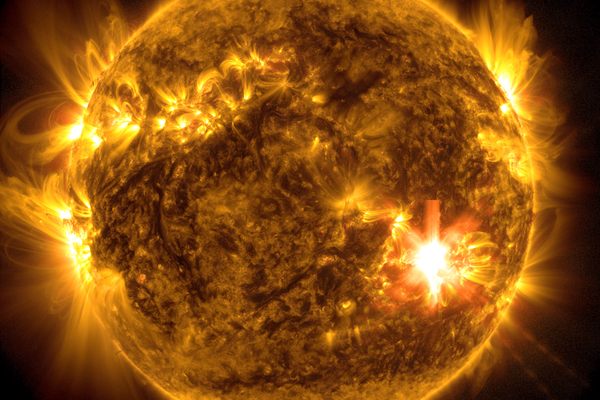Up at Noon, Out All Night: This Summer Camp Is for Serious Stargazers
For more than half a century, the International Astronomical Youth Camp has attracted aspiring astronomers from around the world.
The clouds seemed to be conspiring against Jimo Pereira last summer. The university student from Buenos Aires spent much of her time curled up in a sleeping bag on the grounds of Eichsfelder Hütte, a hostel deep in Germany’s rugged Harz Mountains. Night after chilly night she’d be out in the open field with her project partner, trying to stay warm. Every so often one of them would get up to check their telescope, but the clouds stubbornly barred their view. Then one night, finally, they saw stars.
For hours, the pair took turns checking the alignment of their telescope and camera every 20 minutes that one clear night. They came away not with an Instagram-worthy time-lapse photo, but with data on two distant stars orbiting each other in what’s known as an eclipsing binary system. The two were not scientists, however. At least, not professionally—not yet. They were participants in one of the world’s most unusual summer camps: One devoted to studying the cosmos in constant motion overhead as the camp itself travels around the globe.
This traveling camp is the International Astronomical Youth Camp, an annual three-week program for 16- to 24-year-old lovers of astronomy that’s held at a different location each year. It’s been running every summer (and the occasional winter) since 1969, and has taken place in 15 different countries so far. In August, Pereira will join more than 60 other campers and 10 volunteers from more than 20 countries for her third camp, this time among the crags of Vogtland in eastern Germany, near the Czech border.

It’s eerily quiet on a typical morning during the camp—no one stirs until campers head for noontime breakfast service. From afternoon until midnight, they can participate in a range of activities: arts and crafts, sports, team-building, cultural exchange programs, and, of course, astronomy. Lunch is at 5:30 p.m., dinner is at midnight, and the wee hours of the morning are for the camp’s signature star parties.
On these nights, with hopefully clear skies, everyone grabs their sleeping bags and equipment and takes to the outdoors. Veterans teach newcomers how to work the camp-provided telescopes, and everyone spends the night observing. “Seeing them find something or see something new for the first time…like if they’ve never seen Saturn before—that’s really exciting,” says Carys Herbert. Herbert is the president of the International Workshop for Astronomy, IAYC’s parent organization, an astronomy Ph.D. researcher at the University of Kent, and a former IAYC camper.
For decades, young stargazers have found their way to IAYC through sometimes surprising means. Christoph Münkel, for example, saw an advertisement in a German astronomy magazine back in 1974. A bit of a late bloomer, Münkel attended his first camp when he was 21 years old. That experience kicked off a 16-year run—he returned to IAYC year after year, initially as a camper, then as a leader. Back then, the camp’s equipment was not that different from gear used in what was then the cutting edge of astronomy research—and if you had a decent telescope, which campers did, it was possible that you might make a genuine scientific discovery. The prospect brought excited anticipation to campers’ stargazing as they peered into their scopes with the hope of seeing something never before spotted.

Now a 71-year-old retiree in Hamburg, Münkel feels especially lucky that he was able to participate when he did—including a few years when IAYC was held outside of Europe, including locations in Tunisia and Egypt.
The camp’s forays into Egypt came about thanks to another camper who, like Münkel and many other participants, became a repeat attendee. Back in the early ’80s, when a few friends told him they were going to Germany for the summer and encouraged him to visit, 19-year-old Khaled Shammaa, living in Egypt, didn’t know what to expect. He headed to the tiny village of Violau, nestled in the grassy hills of southern Germany and found IAYC. “I wasn’t even into astronomy,” Shammaa says. But it fascinated him to see so many people from all kinds of backgrounds sharing a passion for the stars. He resolved to take the camp to his homeland.
Shammaa acted as the point person to organize two camps in Egypt a few years later. One year the campers drove from Sharm El-Sheikh, on the Sinai peninsula, into the heart of the desert. “We were surrounded 360 [degrees] by desert…and oh my god, the sky was unbelievable,” says Shammaa. Even now, at 63, he vividly remembers the majesty of the moment, and how, while lying in the sand, you didn’t even need a telescope to see the meteors above. “Everything was as if it was made especially for us,” he says. “It was something magical.”

The two camps Shammaa helped organize bookended IAYC’s forays outside of Europe. But the camp continues to live up to its “International” name by gathering aspiring astronomers from around the world. During the IAYC’s “national evenings,” campers gather to give presentations or lead activities related to their country: anything from Scottish highland dancing to intimate storytelling about growing up in Afghanistan. These nights can be powerful, and sometimes move campers to tears.
With only about 64 spots for the camp each year, the IAYC limits the number of returning campers to around 30, and works to make the cohorts as diverse as possible. Organizers first select campers based on applicants’ anonymized letters of motivation, and then make their final decisions based on nationality, age, and gender to assure balanced representation. This year, only about a third of the 180 hopeful participants secured a spot.
“It gets harder and harder every year,” says Herbert, who is particularly concerned about African countries (with the exception of South Africa) being underrepresented at IAYC.
Cost can be a significant factor in participation; although there are grants to cover camp costs for participants who need financial aid, IAYC is not able to pay for travel expenses. This year, Herbert recalls that one candidate from Botswana had an amazing application and organizers were excited to welcome him. But the candidate could not afford to get himself to the camp.

Chosen applicants who cannot pay for travel miss out on more than three weeks of summer camp fun—IAYC is also a place for campers to network, and to glimpse their potential future. For example, camper Pereira’s home country of Argentina has very few astronomy programs, and the IAYC has given her access to actual astronomy Ph.D. students who show her what her path might look like. It has encouraged her to pursue an interest that might otherwise have seemed out of reach.
In fact, while much of their time at camp is focused upward, on stars millions of light-years away, it turns out that the close and enduring human connections may be the most important part of the IAYC experience. Herbert, Pereira, and Shammaa all talk of deep friendships forged during their time at IAYC. And as for Münkel, in 1982 he met a camper named Jasmina, who later became a professional astronomer. They chatted here and there for a few summers, growing closer. This year they will celebrate their 35th wedding anniversary.


















Follow us on Twitter to get the latest on the world's hidden wonders.
Like us on Facebook to get the latest on the world's hidden wonders.
Follow us on Twitter Like us on Facebook